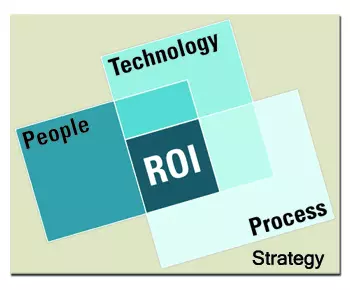Seeing a recent occurrence of finger pointing caused me to wonder – Why don't we see more of this in our practice?

First, some background. We work in many industries and in many areas of a company, yet our projects always ...
- Use Technology to ...
- Improve Processes and thus ...
- Help People perform better, ultimately ...
- Yielding business results (ROI).
Graphically, this becomes:

How do we go about our work? We talk with our client's people, get their insights on the nature of the issue, propose a way to do things better, validate this proposed solution with them, revise the solution as needed, and then develop and implement the solution.
In our work, we make a key assumption:
Our client's people are willing and able to use our work.
Remember – we've worked with our client's personnel all along the way. Assuming we've done our work well, one of three things happens:
- If the people are willing and able to use our work, then results come – success!
- If the people are not able to use our work, then results will not come – this is a problem.
- If the people are not willing to use our work, then results will not come – this is a different type of problem.
If results don't come and we've done our job correctly, the implication? Our client has a people problem – and this typically takes one of two forms:
- Our client has the wrong people "on the bus" for the new method of doing things.
- Lack of Ability – Automating the creation of accounts payable vouchers from the purchase order and the receiving report will change the position from "Accounts Payable Clerk" to "Accounts Payable Analyst." Some people can handle the higher skill set, given training and a period of on-the-job learning ... and some will never be able to grow with the position.
- Lack of Willingness – Implementing an automated scheduling function in an ERP (Enterprise Resource Planning) application requires new tasks to be done. These new tasks typically cause more work in the short-term without apparent benefit – especially since the benefits may not been seen until a number of projects or jobs have been worked using the new method. It's not just GIGO (Garbage In, Garbage Out) – it can also be NINO (Nothing In, Nothing Out). When people follow NINO, they have the ability to do the new tasks – they just choose not to do them.
- Our client has the right people "on the bus" for the new method, yet the executives or managers are not willing or able to hold their people accountable for results. This is a culture issue. Paraphrasing my friend Rich Schlentz: If you want to change the culture, you need to change the leaders, either by developing them to address lack of ability, or replacing them because of an unwillingness to change.
Either way – our client has a people issue. People issues are outside the scope of our practice, so – when we see them – we're happy to connect our client with other firms for help.
Businesses Who Benefit Improving Process & Technology
The clients who get the most benefit from our work? Those who focus on addressing and solving an issue, without making it personal. Such clients recognize that, say, Jane is a competent and hard-working manager, yet results in her area have been falling – thus, let's look for problems in the process and technology Jane and her staff use, and get to the bottom of things without pointing fingers at people.
Such clients have typically created a culture where it's okay to make a mistake, as long as the employee recognizes it, admits it, helps correct it, and learns to do better next time – this is a healthy and helpful environment. Employees in such a culture typically welcome our involvement, because they know neither our recommendations nor the inevitable hiccups coming from implementing a new method will be held against them.
Even in the best of cultures, misunderstandings happen. Fortunately, the best cultures permit misunderstandings and similar small issues to be surfaced and addressed without pointing fingers. Two examples from our practice illustrate this:
Potential Process Miscomunication Outcomes
Many years ago, we designed a program to integrate a client's MRP (Materials Requirements Planning) system and their financial system. Along the way, we automated creation of accounts payable vouchers.
- The issue? The Accounts Payable Manager believed our work caused new problems in her department.
- The outcome? Our work exposed existing problems no one knew were occurring. In this case, the manager's misunderstanding was resolved, and then affected parties – including the manager – worked to fix the problems without affixing blame.
More recently, we helped a client implement the scheduling module for their upgraded ERP system. Following this, we then developed an enhancement to store – both manual "ad hoc" and automatically scheduled – "snapshots" of the planned schedule, and created summary reports to compare a particular snapshot (planned schedule) against actual weekly production.
- The issue? The Shop Manager said our reports were not working, because a report we developed showed the shop was working an unbelievably high number of jobs that had not been scheduled, to the detriment of jobs which had been scheduled and truly needed to get done.
- The outcome? Our report was accurate. The manager had not enforced the procedures required for the scheduling module and our enhancements to work correctly. Once we explained the rationale underlying the necessary procedures and the benefits to be gained, the manager was fully on board, and began enforcing the needed procedures. Things are now running smoothly, and both employees and the company are reaping the benefits of the ERP system and our work.
In these examples, things were resolved quickly and easily. In other instances, we've seen examples of significant finger pointing by client personnel - sometimes at us, and most frequently at their co-workers.
How to eliminate such behavior? The best technique I've found comes from a short, easy-to-read book called QBQ! The Question Behind the Question: Practicing Personal Accountability at Work and in Life, by John G. Miller. The book's premise is simple – people practice personal accountability by asking better questions, and better questions lead to better answers.

The author has three rules for forming a better question, which he calls a QBQ, for "Question Behind the Question." QBQs:
- Begin with "What" or "How" – NOT "Why," "When," or "Who"
- Contain an "I" – NOT "they," "we," or "you"
- Focus on action
Here's a simple question meeting all three rules – "What can I do?" Examples of more substantive questions are:
- How can I do my job better today?
- What solution can I provide?
- How can I help move the project forward?
Admittedly, it takes time and effort for someone to ask better questions and improve one's personal accountability. Still, the results claimed by the author – eliminating blame, victim thinking, complaining, and procrastination – are valuable to the individual and all affected parties ... and may even help someone keep their job.
Returning to the original question – Why don't we see more finger pointing in our practice? Because virtually all of our clients, over our nearly 23 years in business, have developed a healthy and helpful environment where it's okay to identify and fix problems without resorting to finger pointing. This also means executives who retain us don't point fingers within their own organizations. Such executives lead good companies always looking to get better – and better results can never be achieved by pointing fingers.

Todd L. Herman


